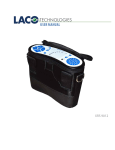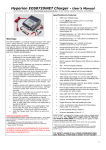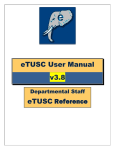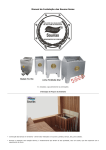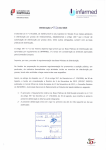Download Total Recall Max Traffic Collector
Transcript
Total Recall Max Traffic Collector User Guide Version: 8.1.0 Date: June 2009 Total Recall Max Traffic Collector - User Guide Page 1 Table of Contents INTRODUCTION ........................................................................................................................................... 3 Acronyms .............................................................................................................................................. 3 DEVICE DESCRIPTION ................................................................................................................................. 4 Overview ............................................................................................................................................... 4 Ports...................................................................................................................................................... 4 Virtual LANs ......................................................................................................................................... 5 Collectors.............................................................................................................................................. 5 Impact on Exiting Network ................................................................................................................... 5 START HERE ............................................................................................................................................... 6 PASSWORD CONFIGURATION ...................................................................................................................... 8 SYSTEM CONFIGURATION ........................................................................................................................... 9 Network Configuration ......................................................................................................................... 9 Ethernet Port Configuration ............................................................................................................... 10 REBOOTING .............................................................................................................................................. 12 COLLECTOR CONFIGURATION .................................................................................................................. 14 MAINTENANCE ......................................................................................................................................... 17 Collector Status................................................................................................................................... 17 Collector Control ................................................................................................................................ 19 Network Diagnostics........................................................................................................................... 19 Collector Logs..................................................................................................................................... 20 EXAMPLE SCENARIOS ............................................................................................................................... 23 Single Traffic Collector Deployment .................................................................................................. 23 Multiple Traffic Collectors Deployment ............................................................................................. 28 APPENDIX A – SPECIFICATIONS ................................................................................................................ 33 Table of Figures Figure 1 - Login page .......................................................................................................... 6 Figure 2 - Password Change page ...................................................................................... 8 Figure 3 - System Configuration page ................................................................................ 9 Figure 4 - System Reboot page.......................................................................................... 12 Figure 5 - System Reboot in Progress page ...................................................................... 13 Figure 6- Collector Configuration page ........................................................................... 14 Figure 7 - Maintenance page ............................................................................................ 17 Figure 8 – Collector Status on the Maintenance page ...................................................... 18 Figure 9 – Collector Control on the Maintenance page.................................................... 19 Figure 10– Network Diagnostics on the Maintenance page ............................................. 20 Figure 11– Collector Logs on the Maintenance page ....................................................... 21 Figure 12- Collector Log page.......................................................................................... 21 Figure 13 – Example: Single Traffic Collector................................................................. 23 Figure 14 – Example: Multiple Traffic Collectors ........................................................... 28 Total Recall Max Traffic Collector - User Guide Page 2 Introduction The Traffic Collector is a device that can be used to collect H.323, SIP and RTP traffic in medium to large VoIP networks and deliver the traffic to one or more Total Recall Max units. For small VoIP networks a Total Recall Max unit with its very useful embedded traffic collection capability may suffice. The Traffic Collector has a web based interface which works with all standard web browsers such as Internet Explorer and Firefox. This publication describes the interface and how it can be used to configure and monitor the operation of a Traffic Collector. Acronyms DNS GUI IP LAN RTP SIP H.323 TCP UDP VLAN VoIP Domain Name Server Graphical User Interface Internet Protocol Local Area Network Real Time Protocol Session Initiation Protocol Suite of VoIP protocols Transmission Control Protocol User Datagram Protocol Virtual LAN Voice over IP Total Recall Max Traffic Collector - User Guide Page 3 Device Description Overview The Traffic Collector is a device that can be used to collect H.323, SIP and RTP traffic in medium to large VoIP networks and deliver the traffic to one or more Total Recall Max units. The Traffic Collector is very attractive option for distributed networks, consisting of multiple subnets. Multiple Traffic Collectors can be placed in strategic places on the network, where H.323, SIP and RTP traffic can be captured and delivered to one or more Total Recall Max recording units. The subsequent diagram is an example of such scenario. Internet Provider VoIP Provider Main Office Branch Office SW3 SW1 SW4 SW2 ` ` IP Phones IP Phones ` ` PCs PCs IP Collected Traffic + IP Collected Traffic SW5 Traffic Collector 2 Traffic Collector 1 VoIP IP TR-MAX For small VoIP networks a Total Recall Max unit with its very useful embedded traffic collection capability may suffice. Ports Each Traffic Collector comes with four (4) Ethernet ports and is capable of collecting H.323, SIP and RTP traffic on all ports. However, it may be appropriate, and desirable, to reserve one of the ports for sending H.323, SIP and RTP traffic to Total Recall Max units. Total Recall Max Traffic Collector - User Guide Page 4 Note that access to the web based interface is only available through Ethernet Port 1. Virtual LANs The Ethernet Ports can connect to a VLAN network (IEEE 802.1Q). To enable this feature, specify the VLAN ID during the port configuration. Collectors Up to four (4) individual Collectors can be active on every Traffic Collector. The Collectors are the engines that collect traffic from one or more Ethernet Ports and send the traffic to Total Recall Max units. Each Collector can send traffic to one Total Recall Max; however, more that one Collector can send traffic to the same Total Recall Max. Collectors use a proprietary protocol on top of the TCP or the UDP protocol to send traffic to a Total Recall Max. UDP is an unreliable protocol and packets can get lost in the network for various reasons. As a result, avoid using UDP, or use it only for low traffic volumes – up to 10 active calls. Impact on Exiting Network The Traffic Collector gives enhance flexibility to the Total Recall Max. However, it will have impact on existing network if it connects Traffic Collectors to Total Recall Maxes. The impact is an increase of the amount of traffic that the network needs to support. The Collectors basically send a copy of the H.323, SIP and RTP traffic that they collect to a Total Recall Max. This has the effect of doubling the H.323, SIP and RTP traffic that the network needs to transport. Use a separate network between the Traffic Collectors and Total Recall Maxes to minimise the impact on the existing network. Total Recall Max Traffic Collector - User Guide Page 5 Start Here To access the web based interface of a Traffic Collector for the first time do the following: 1. Connect a computer to the Ethernet Port 1 of the Traffic Collector using a crossover LAN cable. 2. Configure the LAN port that you are using on your computer with the following static IP address: 192.168.3.100, and network mask: 255.255.255.0. 3. Start your favorite web browser, such as Internet Explorer, on the computer and point it to the following address: http://192.168.3.82. The Login page, as shown on the subsequent screen capture, will display in the web browser. Figure 1 - Login page You can change the default IP address (192.168.3.82) of the Ethernet Port 1 to an address using the System menu as explained in the Ethernet Port Configuration section. Total Recall Max Traffic Collector - User Guide Page 6 The Main Menu, which appears on the left-hand side of every page, lets you navigate between the different configuration and monitoring pages once you log in. Main Menu Link System Collectors Maintenance Change Password Exit Reboot Description Displays the System Configuration page which lets you configure the Ethernet Ports and networking parameters. Displays the Collector Configuration page which lets you configure up to four Collectors. By default, all Collectors are disabled. Displays the Maintenance Page which lets you start/stop Collectors, determine the state of each Collector, and perform some basic network diagnostics. Displays the Password Change page which lets you change the password for the “admin” user. Select this link to log out the “admin” user. Displays the System Reboot page which lets you reboot the Traffic Collector. Total Recall Max Traffic Collector - User Guide Page 7 Password Configuration The Traffic Collector has one user that is allowed to gain access to the web interface. The user is “admin”. The default password for the user “admin” is “admin”. You can change this password by using the Password Change page shown on the subsequent screen capture. To access this page click on the Change Password link that appears on the Main Menu. Figure 2 - Password Change page Total Recall Max Traffic Collector - User Guide Page 8 System Configuration The Traffic Collector system configuration comprises: 1. Network configuration 2. Ethernet Port configuration The System link that appears on the Main Menu displays the Traffic Collector System Configuration page shown on the subsequent screen capture. You need to log in before you can access this page. Figure 3 - System Configuration page Reboot the Traffic Collector after making changes in the system configuration. Network Configuration The network configuration specifies the default network communication parameters for the Traffic Collector. Total Recall Max Traffic Collector - User Guide Page 9 Parameter Default Gateway Description This is the default gateway for IP traffic on the network that the Traffic Collector is part of. Note that you can specify a gateway for IP traffic for each Ethernet Port. However, if an Ethernet Port does not specify a gateway, then (if required) the Traffic Collector will use the Default Gateway when sending traffic to a Total Recall Max through the port. The subsequent examples explain different configuration scenarios. The entry in the field with red background is incorrect. Select Cancel to restore the original value(s), or correct the entry in the field with red background. The gateway for all Ethernet Ports that do not specify a gateway is 192.168.3.253. The Traffic Collector does not have a default gateway. Ethernet Port Configuration The Ethernet Port configuration specifies the parameters that prepare ports for IP communication. Observe the following: 1. Ethernet Port 1 must be configured for IP communication as this is the port used to access the web based interface described in this publication. 2. All Ethernet Ports that are used by Collectors to send traffic to Total Recall Max units must be configured for IP communication. 3. Ethernet Ports that are used exclusively to collect H.323, SIP and RTP traffic do not need to be configured for IP communication. 4. The VLAN ID and Default Gateway parameters are optional. The Traffic Collector is not a routing device for IP traffic. It can connect to multiple networks (by connecting different ports to different networks); however, it will not route traffic from one network to another. Parameter IP Address Network Mask Gateway Description The IP address that the port will use for IP communication. It should be a valid IP address for your network. The network mask that the port will use for IP communication. This is an optional parameter and it specifies the default IP Total Recall Max Traffic Collector - User Guide Page 10 VLAN ID traffic gateway for all IP communication through the port. This is an optional parameter and it specifies the 802.1Q tag used on the virtual LAN that the port connects to. The subsequent examples explain different configuration scenarios. The entry in the field with red background is incorrect. Select Cancel to restore the original value(s), or correct the entry in the field with red background. This is an example of a basic Ethernet Port configuration. The port has an IP address (192.168.3.83) and is connected to the 192.168.3.0/24 network. All traffic for other networks will use the Default Gateway (see Network Configuration). The port is not part of a VLAN. This is an example of an Ethernet Port configuration that is similar to the previous one; except that all traffic for other networks will use the specified Gateway (192.168.3.253). This is an example of a basic Ethernet Port configuration for a VLAN. The port has an IP address (192.168.3.83) and is connected to the 192.168.3.0/24 network with VLAN ID 100. All traffic for other networks will use the Default Gateway (see Network Configuration). Total Recall Max Traffic Collector - User Guide Page 11 Rebooting To reboot the Traffic Collector, select the Reboot link on the Main Menu. This shows the System Reboot page which is shown on the subsequent screen capture. Figure 4 - System Reboot page Press the Reboot button to initiate the reboot sequence. The Traffic Collector will display the System Reboot in Progress page, which is shown on the subsequent screen capture, while it is rebooting. Total Recall Max Traffic Collector - User Guide Page 12 Figure 5 - System Reboot in Progress page Finally, when the system reboot is complete, the Traffic Collector will display the Login page (see Figure 1). Total Recall Max Traffic Collector - User Guide Page 13 Collector Configuration Up to four (4) individual Collectors can be active on each Traffic Collector. The Collectors are the engines that collect traffic from one or more Ethernet Ports and send the traffic to one or more Total Recall Max units. The Collector configuration for each Collector specifies: 1. the Ethernet Port(s) that the Collector should use to collect H.323, SIP and RTP traffic; and 2. the Total Recall Max that will receive the H.323, SIP and RTP traffic. The Collectors link that appears on the Main Menu displays the Collector Configuration page shown on the subsequent screen capture. You need to log in before you can access this page. Figure 6- Collector Configuration page Total Recall Max Traffic Collector - User Guide Page 14 Parameter Total Recall Protocol Total Recall IP Address Total Recall Port Ethernet Port Description Collectors use a proprietary protocol on top of the TCP or the UDP protocol to send traffic to a Total Recall Max. UDP is an unreliable protocol and packets can get lost in the network for various reasons. As a result, avoid using UDP, or use it only for low traffic volumes – up to 10 active calls. This is the IP address of the Total Recall Max that will receive H.323, SIP and RTP traffic from the Collector. This is the TCP (or UDP) port the Total Recall Max uses to receive H.323, SIP and RTP traffic from the Collector. The Collector will collect H.323, SIP and RTP traffic on one or more Ethernet Ports as specified by this parameter. The Collector configuration must match the VoIP Settings of the Total Recall Max that will receive traffic from the Collector. The following screen captures are an example of a matching configuration. VoIP Settings (inside the red box) specify that the Total Recall Max expects traffic from collectors on TCP port 10020 and IP address 192.168.3.196. The Collector configuration specifies that the Collector will use TCP to send traffic that it collects on Ethernet Port 1 to IP address 192.168.3.196 and port 10020. The subsequent examples explain different configuration scenarios. The entry in the field with red background is incorrect. Select Cancel to restore the original value(s), or correct the entry in the field with red background. Total Recall Max Traffic Collector - User Guide Page 15 This is an example configuration of a Collector that is disabled. The Collector does not collect traffic and does not send traffic to a Total Recall Max. This is an example configuration of a Collector that is ready to collect traffic and send it to a Total Recall Max. The Collector configuration specifies that the Collector will use TCP to send traffic that it collects on Ethernet Port 1 to IP address 192.168.3.196 and port 10020. Similar to the previous example, this is an example configuration of a Collector that is ready to collect traffic and send it to a Total Recall Max. The Collector configuration specifies that the Collector will use UDP to send traffic that it collects on Ethernet Port 2 and 3 to IP address 192.168.3.200 and port 10020. Total Recall Max Traffic Collector - User Guide Page 16 Maintenance The Traffic Collector Maintenance page allows for: 1. determining the status of the Collectors; 2. starting/stopping Collectors; 3. performing basic network diagnostics such as `ping` and `traceroute`; and 4. viewing the logs for each Collector. The Maintenance link that appears on the Main Menu displays the Traffic Collector Maintenance page shown on the subsequent screen capture. You need to log in before you can access this page. Figure 7 - Maintenance page Collector Status The collector status area, which is shown on the subsequent screen capture, displays the operational status of each Collector. Total Recall Max Traffic Collector - User Guide Page 17 Figure 8 – Collector Status on the Maintenance page Parameter Collector State Connection Status Description The Collector instance. Shows the operational state of the corresponding Collector instance. Possible states are: • Not used – the Collector is not used to collect traffic. • Stopped – the Collector is ready (configured) to collect traffic and send it to a Total Recall Max; however, it is not active. • Running – The Collector is active and it collects traffic. See the Connection Status to determine whether the Collector is sending the traffic it collects to a Total recall Max. Shows the status of the connection between the Collector and the associated Total Recall Max. Possible states are: • Connecting … - the Collector is attempting to establish a connection with the associated Total Recall Max. • “tcp 0 0 <ip address>:<port> <ip address>:<remote port>” – the Collector is sending traffic to the associated Total Recall Max via TCP. The first <ip address>:<port> pair is the IP address and port on the Traffic Collector, while the second is the IP address and port on the Total Recall Max. • “udp 0 0 <ip address>:<port> <ip address>:<remote port>” – the Collector is sending traffic to the associated Total Recall Max via UDP. The first <ip address>:<port> pair is the IP address and port on the Traffic Collector, while the second is the IP address and port on the Total Recall Max. • The Collector status does not update automatically. Click on the Update button to get an up to date status. Total Recall Max Traffic Collector - User Guide Page 18 Collector Control The collector control area, which is shown on the subsequent screen capture, contains controls to start, stop and restart each of the Collectors. Figure 9 – Collector Control on the Maintenance page The controls work on Collectors that are in a state (see Collector Status) other than Not Used. To start a Collector, first select the Start action from the drop down box, and then click on the Submit button. The Maintenance page will update and show the new status of the Collector in the Collector Status area. The steps to stop and re-start a Collector are exactly the same, except select the Stop and Restart action respectively in the drop down box instead of the Start action. Network Diagnostics It is possible to perform the following basic network diagnostics on the Maintenance page: 1. ping a host with a given IP address; and 2. discover the route that packets will take from the Traffic Collector to a host with a given IP address. Both are useful ways to quickly establish whether there is connectivity between the Traffic Collector and a Total Recall Max or a network gateway that must be used to reach a Total Recall Max. Use the network diagnostics area, which is shown on the subsequent screen capture, to perform the diagnostics. Total Recall Max Traffic Collector - User Guide Page 19 Figure 10– Network Diagnostics on the Maintenance page The subsequent examples show the use of the network diagnostics. The entry in the field with red background is incorrect. Select Cancel to clear the fields, or correct the entry in the field with red background. To ping a host, first enter the IP address, then select the Ping radio button and finally click on the Submit link. The screen capture on the side shows what should be a familiar result when the host with the specified IP address responds to the ping. To discover the route that packets will take to a host, first enter the IP address, then select the Traceroute radio button and finally click on the Submit link. The screen capture on the side shows what should be a familiar result of a route to a host. Collector Logs The collector logs area, which is shown on the subsequent screen capture, contains links to the logs for each of the Collectors. Total Recall Max Traffic Collector - User Guide Page 20 Figure 11– Collector Logs on the Maintenance page To view the log of a Collector simply click on the correct link. The Traffic Collector will display the content of the Collector’s log in a Collector Log page, which is shown on the subsequent screen capture. Figure 12- Collector Log page The Collector Log page does not update automatically. Use the browser’s Refresh button to get an up to date information in the log. Total Recall Max Traffic Collector - User Guide Page 21 Total Recall Max Traffic Collector - User Guide Page 22 Example Scenarios Single Traffic Collector Deployment This scenario shows the deployment and configuration of a single Traffic Collector on a site that has two floors. Each floor has its own network for VoIP traffic. Single Traffic Collector Deployment VoIP Provider Internet Provier R1 R2 SW4 SW3 SW1 SW2 Mirror Mirror ` Floor 1 IP Phones Floor 2 IP Phones ` Floor 1 PCs IP Traffic Collector ` ` ` ` Floor 2 PCs SW5 Collected VoIP VoIP IP TR-MAX Figure 13 – Example: Single Traffic Collector The following assumptions apply: • The IP phones on floor 1 are connected to a single Ethernet switch (SW1) and are part of a single network: 192.168.1.0/24. • The IP phones on floor 2 are also connected to a single Ethernet switch (SW2) and are part of a single network: 192.168.2.0/24. • There is a single VoIP router (R1) that connects to the VoIP provider. • Similar to the IP phones, the PCs on floor 1 are connected to a single Ethernet switch (SW3) and are part of a single network: 192.168.3.0/24. The default gateway on this network is 192.168.3.253. After doing some preliminary network assessment we decide that it is not a good idea to introduce extra traffic in the existing network (especially through SW1 and SW2) by deploying the Total Recall Max and the Traffic Collector. As a result, our decision is to Total Recall Max Traffic Collector - User Guide Page 23 introduce a separate switch (SW5) that will carry the H.323, SIP and RTP traffic between the Total Recall Max and the Traffic Collector. Further, our decision is to connect the Traffic Collector as follows: • We will use Ethernet Port 1 to send all traffic that the unit collects to the Total Recall Max. We connect this port to SW5. • We will use Ethernet Port 2 to collect all traffic on floor 1, so we connect this port to SW1. • We will use Ethernet Port 3 to collect all traffic on floor 1, so we connect this port to SW2. • Ethernet Port 4 will not be used. Finally, our decision is to provide management access to the Total Recall Max and the Traffic Collector from the 192.168.3.0/24 network. As a result, we make a connection between SW5 and SW3 as shown on the previous diagram. Also, the network administrator was kind enough to give us IP address 192.168.3.196 for the Total recall Max and IP address 192.168.3.82 for the Traffic Collector. Now we are ready to configure the Total Recall Max. Using the Network Settings dialog, first we assign an IP address, a network mask and a gateway to the LAN 1 port of the Total Recall Max as shown on the following screen capture. Then, using the VoIP Settings dialog, we configure the Total Recall Max to accept H.323, SIP and RTP traffic on the IP address previously assigned to the LAN 1 port, and TCP port 10020. The configuration is shown on the subsequent screen capture (the parameters inside the red rectangle). Total Recall Max Traffic Collector - User Guide Page 24 At this point the Total Recall Max is ready to accept traffic from the Traffic Collector. So we can proceed with the configuration of the Traffic Collector. The Ethernet Port 1 on the Traffic Collector must be configured for IP communication as it will be used to send traffic to the Total Recall Max. The subsequent screen capture shows the correct configuration. Ethernet Port 2 and 3 do not need to be configured for IP communication as we only plan to use them to collect H.323, SIP and RTP traffic. The subsequent screen capture shows the correct configuration. Total Recall Max Traffic Collector - User Guide Page 25 Now is the time to reboot the Traffic Collector – we made changes to the System Configuration. Once the Traffic Collector is functional again, we can proceed with the configuration of the Collectors. We only need two Collectors so we will use Collector 1 and 2. It is possible to use one Collector as well, but for the purpose of this example we will use two. The subsequent screen capture shows the correct configuration. We also disable Collector 3 and 4. The subsequent screen capture shows the correct configuration. Total Recall Max Traffic Collector - User Guide Page 26 Finally, using the Maintenance page, we start Collector 1 and 2. We can observe the status of the connections on the same page. The subsequent screen capture shows what the status will look like if the Traffic Collector connects to the Total Recall Max successfully. One last note: the Traffic Collector will collect H.323, SIP and RTP traffic only if it “sees” the traffic on Ethernet Port 2 and 3. This is only possible if SW1 and SW2 mirror all VoIP traffic to their ports that connect to the Traffic Collector. Total Recall Max Traffic Collector - User Guide Page 27 Multiple Traffic Collectors Deployment This scenario shows the deployment and configuration of multiple Traffic Collectors, one at each site. Each site has its own network for VoIP traffic. Internet Provider VoIP Provider Main Office Branch Office SW3 SW1 SW4 SW2 ` ` IP Phones IP Phones ` ` PCs PCs IP Collected Traffic + IP Collected Traffic SW5 Traffic Collector 2 Traffic Collector 1 VoIP IP TR-MAX Figure 14 – Example: Multiple Traffic Collectors The following assumptions apply for the Main Office site: • The IP phones are connected to a single Ethernet switch (SW1) and are part of a single network: 192.168.1.0/24. • There is a single VoIP router (R1) that connects to the VoIP provider. • Similar to the IP phones, the PCs are connected to a single Ethernet switch (SW2) and are part of a single network: 192.168.3.0/24. The default gateway on this network is 192.168.3.253. The following assumptions apply for the Branch Office site: • The IP phones are connected to a single Ethernet switch (SW3) and are part of a single network: 192.168.2.0/24. • There is a single VoIP router (R1) that connects to the VoIP provider. • Similar to the IP phones, the PCs are connected to a single Ethernet switch (SW4) and are part of a single network: 192.168.4.0/24. The default gateway on this network is 192.168.4.253. Total Recall Max Traffic Collector - User Guide Page 28 After doing some preliminary network assessment we decide that it is a good idea to minimise the extra traffic in the existing network (especially through SW2 and SW4) by deploying the Total Recall Max and a Traffic Collector. As a result, our decision is to introduce a separate switch (SW5) that will carry the H.323, SIP and RTP traffic between the Total Recall Max and the Traffic Collector at Main Office site. Note that the Traffic Collector at the Branch Office site will need to use SW4 and SW2 to deliver the traffic it collects to the Total Recall Max. Further, our decision is to connect the Traffic Collector at Main Office site as follows: • We will use Ethernet Port 1 to send all traffic that the unit collects to the Total Recall Max. We connect this port to SW5. • We will use Ethernet Port 2 to collect all traffic on this site, so we connect this port to SW1. • Ethernet Port 3 and 4 will not be used. Next, our decision is to connect the Traffic Collector at Branch Office site as follows: • We will use Ethernet Port 1 to send all traffic that the unit collects to the Total Recall Max. We connect this port to SW4. • We will use Ethernet Port 2 to collect all traffic on this site, so we connect this port to SW3. • Ethernet Port 3 and 4 will not be used. Finally, our decision is to provide management access to the Total Recall Max and the Traffic Collectors from the 192.168.3.0/24 network. As a result, we make a connection between SW5 and SW3 as shown on the previous diagram. Also, the network administrator was kind enough to give us IP address 192.168.3.196 for the Total recall Max, IP address 192.168.3.82 for the Traffic Collector at the Main Office site and the IP address 192.168.4.100 for the Traffic Collector at the Branch Office site. Now we are ready to configure the Total Recall Max. Using the Network Settings dialog, first we assign an IP address, network mask and a gateway to the LAN 1 port of the Total Recall Max as shown on the following screen capture. Then, using the VoIP Settings dialog, we configure the Total Recall Max to accept H.323, SIP and RTP traffic on the IP address previously assigned to the LAN 1 port, and TCP Total Recall Max Traffic Collector - User Guide Page 29 port 10020. The configuration is shown on the subsequent screen capture (the parameters inside the red rectangle). At this point the Total Recall Max is ready to accept traffic from the Traffic Collectors. So we can proceed with the configuration of the Traffic Collectors. The Ethernet Port 1 on the Traffic Collector at both sites must be configured for IP communication as it will be used to send traffic to the Total Recall Max. The subsequent screen capture shows the correct configuration for the Traffic Collector at the Main Office site. The subsequent screen capture shows the correct configuration for the Traffic Collector at the Branch Office site. Total Recall Max Traffic Collector - User Guide Page 30 All other Ethernet Ports, on both Traffic Collectors, do not need to be configured for IP communication as we only plan to use them to collect H.323, SIP and RTP traffic, or not use them at all. The subsequent screen capture shows the correct configuration for all other ports. Now is the time to reboot both Traffic Collectors – we made changes to the System Configuration. Once the Traffic Collectors are functional again, we can proceed with the configuration of the Collectors on each. We only need one Collector on each so we will use Collector 1. The subsequent screen capture shows the correct configuration for Collector 1 at the Main Office site. The subsequent screen capture shows the correct configuration for Collector 1 at the Branch Office site. Total Recall Max Traffic Collector - User Guide Page 31 Yes, the configuration for both Collectors is the same. That is because both will send the H.323, SIP and RTP traffic that they collect to the same Total recall Max, and both are using Ethernet Port 2 to collect H.323, SIP and RTP traffic. We also disable all other Collectors (2, 3 and 4) on both Traffic Collectors. The subsequent screen capture shows the correct configuration for all of disabled Collectors. Finally, using the Maintenance page, we start Collector 1 on both Traffic Collectors. We can observe the status of the connections on the same page. The subsequent screen capture shows what the status will look like if the Traffic Collector at the Main Office site connects to the Total Recall Max successfully. The result should be the same for the Traffic Collector at the Branch Office site. One last note: the Traffic Collectors will collect H.323, SIP and RTP traffic only if they “sees” the traffic on Ethernet Port 2. This is only possible if SW1 and SW3 mirror all VoIP traffic to their ports that connect to the Traffic Collectors. Total Recall Max Traffic Collector - User Guide Page 32 Appendix A – Specifications Parameter CPU Memory Storage Network Interface USB Console Power LED Operating Temperature Storage Temperature Chassis Material Dimensions Description On board low power VIA C7 1GHz processor. 512Mb DDR2 400. CompactFlash 1Gb Four 10/100Mbps Ethernet ports (RJ-45). Two ports (disabled). One port (disabled). External power adapter 12V, 5A. Power, HDD, Link/act with transfer rate. 0ºC - 45ºC (32ºF - 113ºF) -20ºC - 70ºC (-4ºF - 158ºF) Steel 44mm(1.73˝)(H) x 210mm(8.27˝)(W) x 150mm(5.91˝)(D) Total Recall Max Traffic Collector - User Guide Page 33





































